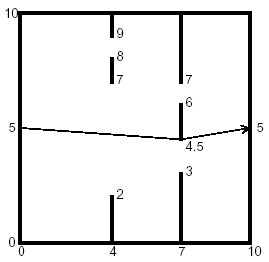poj 1556 The Doors (建图+最短路)
思路:
将一个门可以看成两个点,将所有点建图,如果两点能到达,则距离为坐标距离,不能到达则距离为INF。
ps:其他点是没有用的,这个可以根据三角形的两边之和大于第三边和两点之间线段最短证明。
代码:
#include <iostream>
#include <cstdio>
#include <cstring>
#include <cmath>
#define maxn 105
using namespace std;
const int INF=0x3f3f3f3f;
int n,m,ans,dcnt,pcnt;
bool vis[maxn];
double dist[maxn];
double city[maxn][maxn];
struct Node
{
double x1,y1,y2;
} door[55]; // 开始开小了 WA了一次 一道墙有两个门
struct node
{
double x,y;
} point[maxn];
void init()
{
int i,j;
for(i=1; i<=80; i++)
{
dist[i]=INF;
for(j=1; j<=80; j++)
{
city[i][j]=INF;
}
}
memset(vis,0,sizeof(vis));
}
void Dijkstra()
{
int i,j,mi,k,now=1;
vis[1]=1;
dist[1]=0;
n=pcnt;
for(i=1; i<n; i++)
{
for(j=1; j<=n; j++)
{
if(!vis[j]&&city[now][j]+dist[now]<dist[j])
dist[j]=city[now][j]+dist[now];
}
mi=INF;
for(j=1; j<=n; j++)
{
if(!vis[j]&&dist[j]<mi)
{
mi=dist[j];
k=j;
}
}
now=k;
if(k==n) break ;
vis[k]=1;
}
}
bool isok(int k1,int k2) // 判断两点之间能否到达
{
int i,j;
double k,x,y,xx1,yy1,xx2,yy2;
xx1=point[k1].x;
yy1=point[k1].y;
xx2=point[k2].x;
yy2=point[k2].y;
k=(yy2-yy1)/(xx2-xx1);
for(i=1; i<=dcnt; i+=2)
{
if(door[i].x1<=xx1) continue ;
if(door[i].x1>=xx2) break ;
x=door[i].x1;
y=yy1+k*(x-xx1);
if(!(y>=door[i].y1&&y<=door[i].y2||y>=door[i+1].y1&&y<=door[i+1].y2)) return false ;
}
return true ;
}
double caldist(int k1,int k2) // 计算两点之间的距离
{
double xx,yy;
xx=(point[k1].x-point[k2].x);
yy=(point[k1].y-point[k2].y);
return sqrt(xx*xx+yy*yy);
}
void buildgraph() // 建图
{
int i,j;
for(i=1; i<=pcnt; i++)
{
for(j=i+1; j<=pcnt; j++)
{
if(point[i].x==point[j].x) continue ;
if(isok(i,j)) city[i][j]=city[j][i]=caldist(i,j);
}
}
}
int main()
{
int i,j;
double x1,y1,y2,yy1,yy2;
while(scanf("%d",&n),n!=-1)
{
init();
dcnt=pcnt=0;
pcnt++;
point[pcnt].x=0;
point[pcnt].y=5;
for(i=1; i<=n; i++) // 加door 加point
{
scanf("%lf%lf%lf%lf%lf",&x1,&y1,&y2,&yy1,&yy2);
dcnt++;
door[dcnt].x1=door[dcnt+1].x1=x1;
door[dcnt].y1=y1;
door[dcnt].y2=y2;
dcnt++;
door[dcnt].y1=yy1;
door[dcnt].y2=yy2;
pcnt++;
point[pcnt].x=x1;
point[pcnt].y=y1;
pcnt++;
point[pcnt].x=x1;
point[pcnt].y=y2;
pcnt++;
point[pcnt].x=x1;
point[pcnt].y=yy1;
pcnt++;
point[pcnt].x=x1;
point[pcnt].y=yy2;
}
pcnt++;
point[pcnt].x=10;
point[pcnt].y=5;
buildgraph();
Dijkstra();
printf("%.2f\n",dist[n]);
}
return 0;
}
